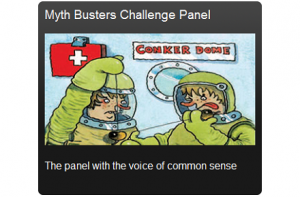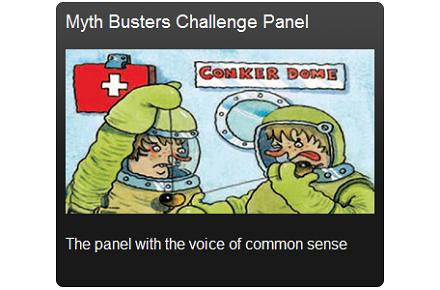There is no shortage of daft decisions being blamed on health and safety. Over the years, the Health and Safety Executive has tackled some quite incredible myths about what health and safety bans or orders people to do.
 |
| [relatedPosts title=”Related Posts”] |
|
|
It’s hard to tell where some of these ridiculous and baffling myths originate, but they all have one crucial thing in common – they are not required by health and safety law.
To mark the launch of the new Myth Busters Challenge Panel, HSE has published its top ten worst myths. They want people to work with them to challenge these myths – the time has come to end the madness!
Myth: Kids must wear goggles to play conkers
The reality
This is one of the oldest chestnuts around, a truly classic myth. A well-meaning head teacher decided children should wear safety goggles to play conkers. Subsequently some schools appear to have banned conkers on ‘health & safety’ grounds or made children wear goggles, or even padded gloves!
Realistically the risk from playing conkers is incredibly low and just not worth bothering about. If kids deliberately hit each other over the head with conkers, that’s a discipline issue, not health and safety.
Myth: Workers are banned from putting up Christmas decorations in the office
The reality
Bah Humbug! Each year we hear of companies banning their workers from putting up Christmas decorations in their offices for ‘health and safety’ reasons, or requiring the work to be done by a ‘qualified’ person.
Most organisations including HSE and local councils manage to put up their decorations, celebrating the spirit of Christmas without a fuss. They just sensibly provide their staff with suitable step ladders to put up decorations rather than expecting staff to balance on wheelie chairs.
Myth: New regulations would require trapeze artists to wear hard hats
The reality
Despite being widely reported at the time and regularly repeated since, this story is utter nonsense. There never were any such regulations.
Hard hats do an excellent job of protecting building workers from falling debris – but they have no place on a trapeze.
Myth: Health and safety risks stop children playing ‘pin the tail on the donkey’
The reality
We recently read that the traditional party game ‘pin the tail on the donkey’ is allegedly under threat because parents consider it a health and safety risk.
Not trusting children with drawing pins seems a little overprotective to us. After all, millions of children have been playing traditional party games like this for years without any problems.
Was this just a marketing ploy to drum up sales of party games?
Myth: Health and safety brings candyfloss to a sticky end
The reality
Come the summer sun and what tops off a great day out better than good, oldfashioned candyfloss?
But if you believe some newspaper headlines this beloved sweet treat is under threat – because of the dangers posed by the stick it is spun around.
The truth is that there are no health and safety laws banning candyfloss on a stick.
Is the traditional form of this sweet disappearing because it is easier to mass produce and store it in plastic bags? Who knows, but it certainly isn’t health and safety leaving anyone with a bad taste in their mouth.
Myth: Health and safety laws banned hanging baskets
The reality
Back in 2004 a town did briefly take down its hanging baskets over fears that old lamp posts would collapse. This was an overly-cautious reaction to a low risk.
However, after quick checks the hanging baskets were replaced and have been on lamp posts in the town every year since.
Despite this, the story continues to be repeated and the danger is someone will believe it is a genuine requirement and follow suit.
Myth: HSE bans traditional school ties
The reality
As we said at the start of the last school year, few parents would see wearing ties at school as a safety issue. Millions of children have been wearing ties as part of their uniform for years without any problems.
Simple precautions such as removing the tie during laboratory work or around machinery make sense. But if the concern is really about children fighting, while clip-on ties may help, the real issue is discipline.
So HSE doesn’t ban school ties – it’s up to schools to make their own decisions about uniforms.
Myth: All park benches must be replaced because they are 3 inches too low
The reality
When we heard this story it really took us by surprise. How could there be health & safety law on this? The simple answer is, there isn’t.
‘It seems that the story originated from a decision by a facility manager and has no basis in health and safety law at all. There are no such bench height requirements and HSE will definitely not be sending our inspectors around measuring the benches!
Well, it looks like Britain’s park benches will survive after all!
Myth: You can’t wear flip-flops to work
The reality
During the summer, many of us think about wearing sandals or flip-flops to work to help us stay cool. Despite recent reports to the contrary, health and safety law doesn’t ban them.
However, slips, trips and falls do account for about 30% of all workplace accidents, and what you wear on your feet can make a difference. So, if you work somewhere where the floor can’t be kept dry or clean then wearing shoes that fit well and have a good grip would be a better choice than flip-flops.
Myth: Graduates are banned from throwing mortar boards
The reality
Health and safety law doesn’t stop graduates having fun and celebrating their success in the time-honoured fashion!
The chance of being injured by a flying mortar board is incredibly small, and when the concern is actually about the hats being returned in good condition, it’s time to stop blaming health and safety.
Source: HSE
.





